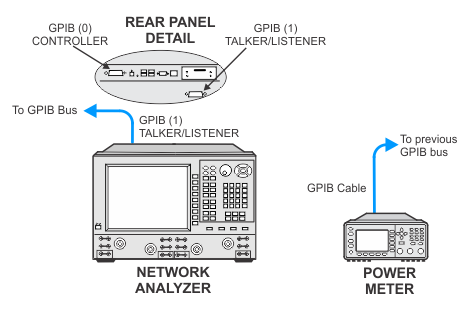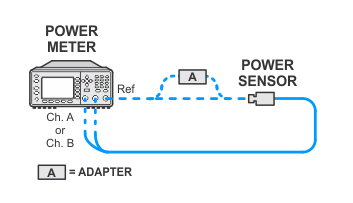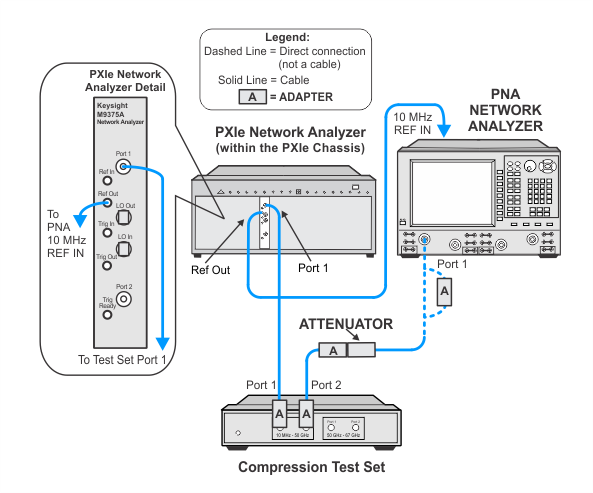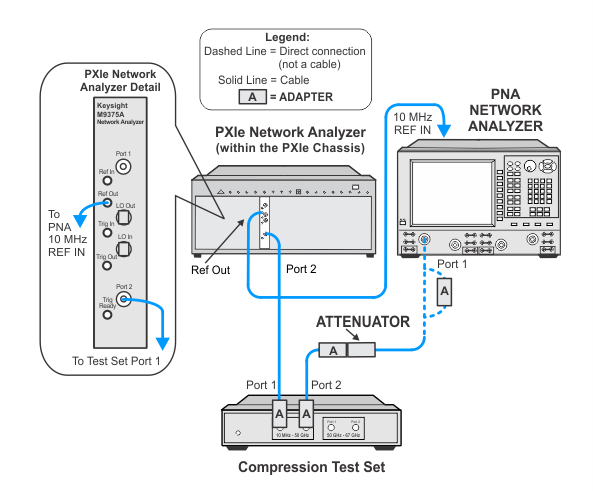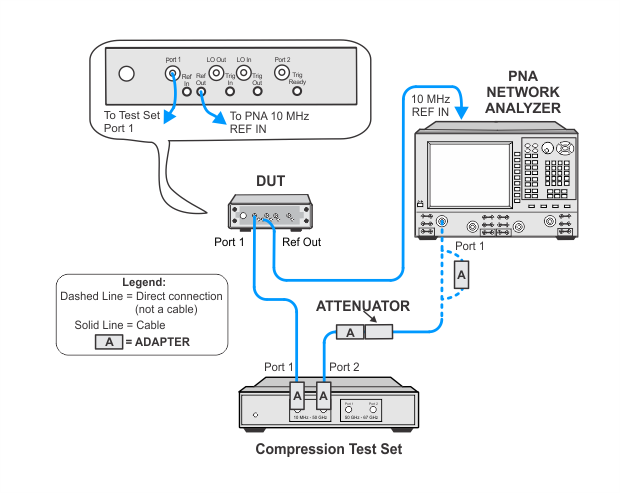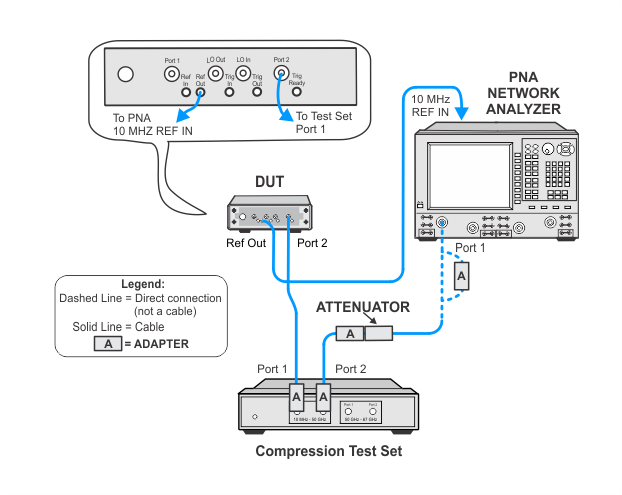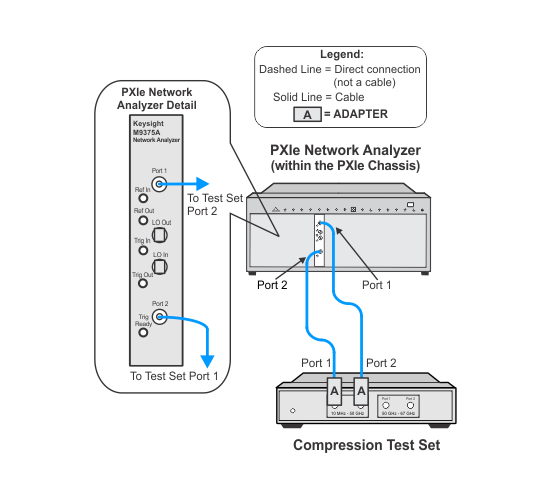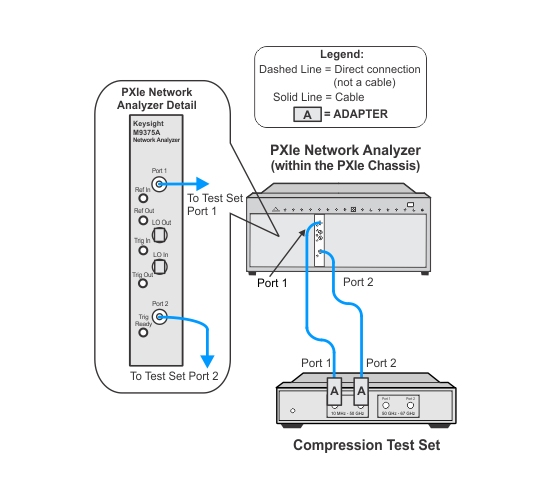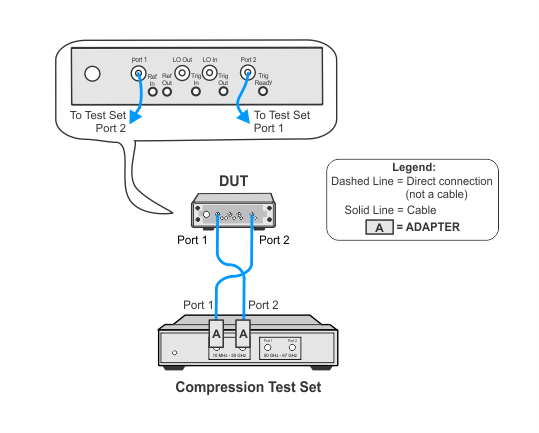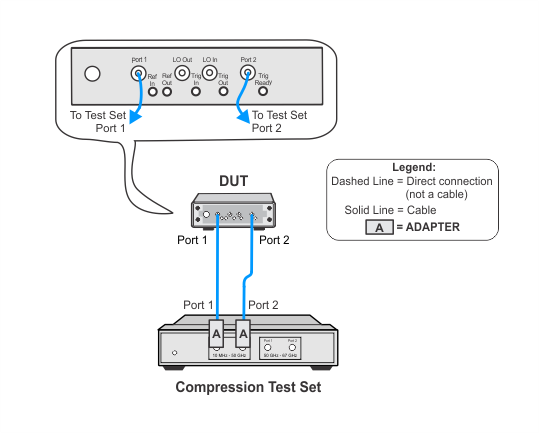Receiver Compression Performance Test
This test verify the linearity of a receiver at high power levels. Receiver non-linearity at high power levels is often termed compression. The procedure measures the non-linearity of the receiver at a specified power level relative to a power level within its linear range. This is accomplished by making a relative measurement over a power step in which the upper step power is the desired test power level. For this test, compression is defined as the difference between the power step (delta power) input to the receiver and the power step (delta power) measured by the receiver. If a constant phase relationship can be maintained at the receiver, then the receiver compression can be measured in both magnitude and phase.
PNAasPowerMeter
One port of the VNA is used as a source while the other port's receiver is under test. Since the VNA source has high harmonic content, a broadband power sensor cannot be used to set the test power level. For this measurement, a calibrated PNA is used as the filtered power level measurement standard.
A SmartCal procedure called PNAasPowerMeter will calibrate the PNA to be used for the power level measurement standard. The data from the SmartCal can be recalled from a previous test providing it's within four hours and the cable and attenuator connections have not been disturbed. Otherwise the PNAasPowerMeter calibration procedure must be repeated. Refer to Connections and Setup Procedures below for more information.
Click here for troubleshooting help.
|

|
TME will present a prompt that offers the user the choice to perform the calibration before starting the test at hand even if it's been within the allowed timeframe. Existing data can be used, if available. For troubleshooting, it is recommended to re-do the calibration especially if you are unsure if the adapter/cable/attenuator setup has been disturbed or disconnected.
|
Required Test Equipment
|
PNA network analyzer
|
N5245B
|
|
Attenuator, 10 dB
|
8493C Option 010
|
|
Power meter2
|
N1914A
|
|
Power sensor2
|
N8485A
|
|
Attenuator, 10 dB
|
8493C Option 010
|
|
ECal module, 3.5 mm
|
N4691D3 Option M0F
|
|
Compression test set4
|
U3070BK01
|
|
Cable, 3.5 mm (m) to 3.5 mm (f)
(qty. 3 required)
|
8121-2111
|
|
Adapter, 3.5 mm (f) to 3.5 mm (f)
|
83059B
|
|
Adapter, 3.5 mm (m) to 2.4 mm (m)
(qty. 2 required)
|
11904A
|
- Refer to the main required equipment table for a list of alternate models.
- For PNAasPowerMeter procedure. If able to recall data from previous PNAasPowerMeter procedure, this equipment is not required for this test.
- D-Model ECals have minimum firmware requirements for the DUT and network analyzer ETE. Refer to the footnote in the Required Equipment table for specific requirements.
-
If needed, the GPIB address on the test set can be modified by following these steps ( click here): click here):
- Connect the new test set to the LAN.
- Open Keysight IO from the PC.
- Select Add Instrument from the menu.
- In the Add LAN Instrument window, locate the new test set on the LAN.
- Select the web page for the new test set and select the View & Modify Configuration tab at the left.
- Select Modify Configuration.
-
Change the GPIB address and select Save.
The test set should now have the updated GPIB address.
|
Connections and Setup Procedures
|

|
To ensure best test results, use a good quality cable, adapter, and attenuator. Do not disturb the adapter/cable/attenuator setup attached to the PNA.
Because the data from the PNAasPowerMeter calibration is stored and re-used by other tests, it is important that the most accurate data is achieved by following these practices.
|
PNAasPowerMeter
This test uses a procedure called PNAasPowerMeter. A calibrated PNA receiver will be used as the filtered power level measurement standard. This receiver is a combination of a PNA with a cable connected to one of the test ports, and a 10 dB attenuator connected to the end of the test cable. The attenuator is used to minimize the measurement uncertainty due to the VNA port mismatch.
Unless recalling stored data from a previously run PNAasPowerMeter procedure, or if the cable, adapter, or attenuator attached to the PNA has been disturbed, this process must be performed prior to running the test.
Flexible power sensor channel assignment
This test will use flexible power sensor channel assignment that will identify the channel that a power sensor is connected to using the ability of "smart" sensors such as the N848xA series power sensors to report their full model and serial number. Therefore it is important to keep the power sensor on the channel where it was calibrated throughout the test procedures.
Click on the drop-down links below to view setup images.
 PNAasPowerMeter Calibration Procedures
PNAasPowerMeter Calibration Procedures
|

|
The illustrations below show details of the GPIB connections of the power meter and the PNA. After the power sensor calibration, the PNA will directly control the power meter through the GPIB cable. In order for this to occur, be sure when making the GPIB connections to:
-
Leave the power meter's GPIB cable connected to the power meter.
-
Disconnect the other end of the power meter's GPIB cable from the GPIB bus.
-
Now take that disconnected end of the GPIB cable and connect it to the GPIB(0) CONTROLLER on the rear of the PNA. Refer to the Rear Panel Detail in the illustrations below.
-
Make sure that power meter's GPIB cable is only connected to the GPIB(0) CONTROLLER of the PNA and that the PNAS's GPIB(1) TALKER/LISTENER is connected to the GPIB bus of the PC.
|
Step one of the PNAasPowerMeter calibration procedure
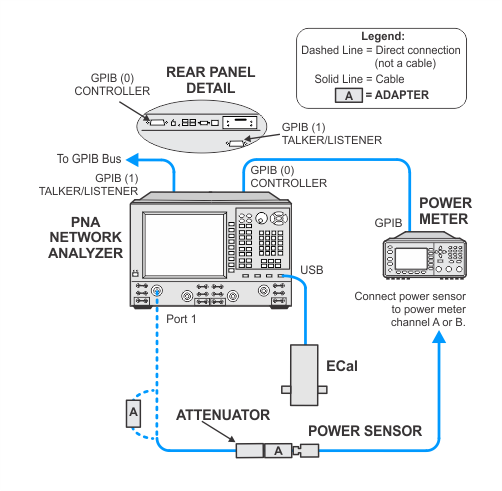
Step two of the PNAasPowerMeter calibration procedure
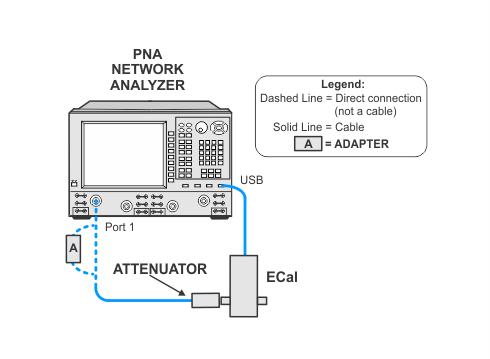
Step three of the PNAasPowerMeter calibration procedure
